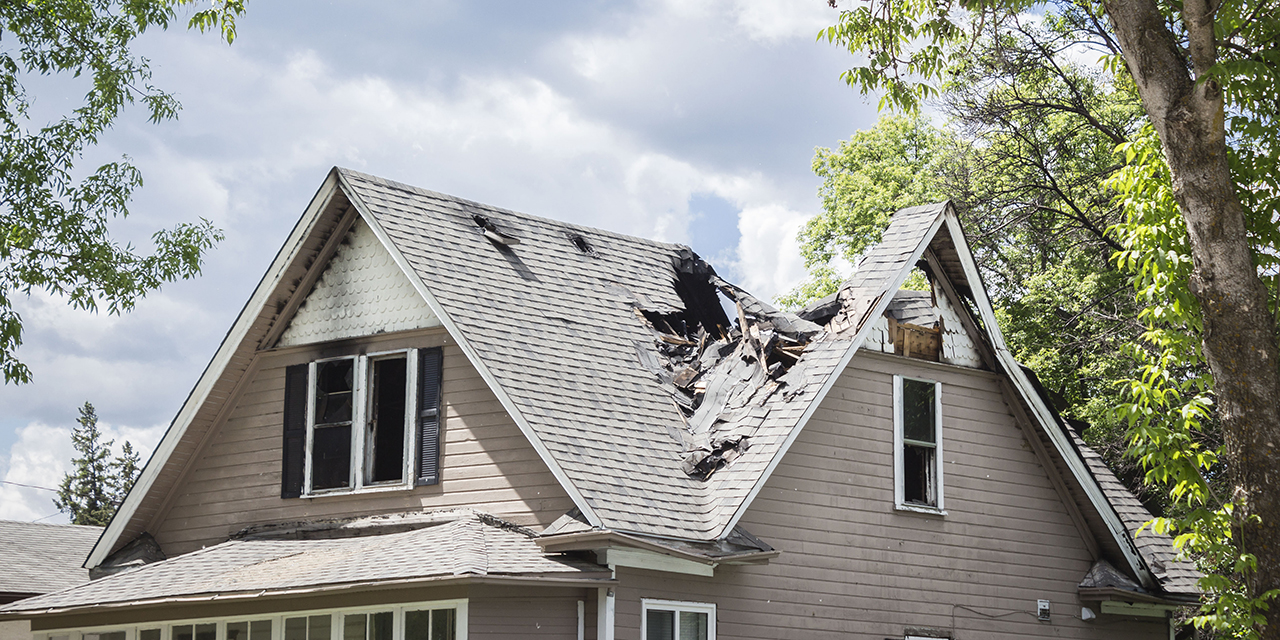
Finding Tax Relief Following a Catastrophic Loss
Among the many tax law changes included in the 2017 Tax Cuts & Jobs Act was a temporary modification of the personal casualty loss rules. While the casualty loss deduction may be unavailable in most cases now, the window is not completely closed on this tax benefit, and it can provide a bit of relief in an otherwise difficult time.
What Qualifies as a “Casualty Loss?”
If you experienced a loss that resulted from casualty, you might be able to deduct it on your tax returns. To define what kinds of events would qualify:
Casualty Loss
A casualty loss refers to damage, destruction or loss of property resulting from an identifiable event that is sudden, unexpected and unusual. These are usually events like earthquakes, fires or hurricanes, but can also include terrorist attacks or vandalism.

Under current law, only personal casualty losses that incurred between 2018 and 2025 and are attributable to a federally declared disaster (i.e., a disaster that warrants federal assistance under the Stafford Disaster Relief and Emergency Assistance Act) are deductible on federal tax returns. Other losses, such as from a car accident or a home break-in, are not deductible under the current law.
How Is a Casualty Loss Determined?
If a qualifying casualty has occurred, the value of the loss is generally limited to the owner’s cost basis in the property – in other words, what they paid for it, not what it was worth. The following steps are used to determine the net value of the loss:
- Determine both (1) the adjusted basis of the property before the event (i.e., what you paid for it, plus or minus adjustments for improvements or depreciation), and (2) how much the property’s fair market value decreased after the event.
- Take the lesser of those two amounts and compare that to any insurance proceeds or other reimbursement received.
If the reimbursement amount is less than the amount determined in Step 1, that difference is a casualty loss and may be tax-deductible. If the reimbursement amount exceeds the amount determined in Step 1, the excess is a casualty gain and may be considered taxable.
Example: A taxpayer purchased a home for $200,000. The home was appraised for $275,000 before it was damaged in a hurricane, but an appraiser determined the home was worth only $175,000 after the storm. The homeowner’s insurance company reimbursed them $80,000. In this case, you would have a casualty loss of $20,000: $100,000 (the lesser of the adjusted basis of the home [$200,000] or the lost fair market value [$275,000 – $175,000, or $100,000]), reduced by the $80,000 of insurance coverage.
How Would Fair Market Value Be Determined?
While the IRS recommends getting an appraisal to determine a property’s fair market value after an event, other options are available if an appraisal isn’t practical.
For Personal-Use Residential Properties
Personal-use residential properties have several safe-harbor methods for calculating lost fair market value. These methods can only be used by the owner of a property that contains at least one personal residence (note: only single-family homes, townhomes or duplexes), and no part of that residence can be used as a rental or home office for a business.
- The de minimis method. Under this method, the loss is based on a good-faith estimate of the cost of repairs needed to return the property to its pre-event condition. This method can only be used for losses of $5,000 or less.
- The estimated cost method. Under this method, the decrease in fair market value can be determined by using the lesser of two repair estimates done by separate, independent licensed contractors. This method can only be used for losses of $20,000 or less.
- The insurance method. Under this method, the loss is equal to the estimated loss set forth in reports prepared by the homeowner’s or flood insurance company. There is no loss threshold for this method.
For Disaster Areas
For losses in disaster areas and due to a federally declared disaster, two other safe harbors are available:
- The contractor method. Under this method, a homeowner can rely on the price in a signed, binding contract for repairs by an independent, licensed contractor.
- The disaster loan appraisal method. This method allows an owner to use the loss identified in an appraisal used to apply for federal loan assistance.
For Personal Belongings
There are also safe harbors available to determine the lost fair market value for personal belongings:
- The de minimis method. Similar to that for personal-use residential properties, this method of valuing the loss is based on the owner’s good-faith estimate of the lost fair market value of the belongings, up to $5,000. Owners must maintain records describing the items and the method for determining their value.
- The replacement cost method. This method allows an owner to determine the fair market value of personal belongings by establishing the cost to replace the items with a new one, and then reducing that cost by 10% for each year the original item was owned (with a maximum reduction of 90%).
All of these safe harbor methods are subject to additional rules and exceptions. Even when using a safe harbor method, the loss on the real property or personal belonging is still limited to the lesser of the adjusted basis of the items or their lost fair market value. Also, safe harbor methods do not apply to items used in a trade or business or items that maintain or increase their value over time, like cars, boats and other vehicles.
How Is the Tax Deduction Calculated?
IRS Form 4684 is used to calculate the net deductible casualty loss. If a single casualty causes damage to multiple items, the owner must first determine the net loss for each individual item. (Real estate owned for personal use is an exception – in that case, all improvements to the property, such as attachments or landscaping, can be considered together with the main property itself as one item.)
Example: A taxpayer purchased a home for $200,000. The home was appraised for $275,000 before it was damaged in a hurricane, but an appraiser determined the home was worth only $175,000 after the storm. The homeowner’s insurance company reimbursed them $80,000. In this case, you would have a casualty loss of $20,000: $100,000 (the lesser of the adjusted basis of the home [$200,000] or the lost fair market value [$275,000 – $175,000, or $100,000]), reduced by the $80,000 of insurance coverage.
Now let’s say the homeowner’s two cars were also destroyed. One was purchased for $25,000 and was worth $10,000 at the time of the hurricane, and the insurance company paid $7,000 for the loss. The second car was a collector car purchased for $30,000 and now worth $50,000, but it was uninsured. The gross loss on the first car was $10,000 (because the lost fair market value was less than adjusted basis). The insurance proceeds of $7,000 offset this amount, leaving a net loss of $3,000. The gross loss on the second car was $30,000 (because the adjusted basis was less than lost FMV), but with no insurance proceeds the net loss was also $30,000.
To determine the actual tax deduction for these losses, there are two other rules that must be applied:
- The $100 rule. This rule states that each casualty must be reduced by $100. If multiple items are damaged or lost in events that are closely related, the $100 rule will apply to the total loss. If the events are unrelated, however, each loss must be reduced by $100.
- The 10% rule. This rules states that the total loss across all events, after applying the $100 rule, is reduced by 10% of the adjusted gross income of the taxpayer. Any loss beyond that is then tax-deductible.
Once both the $100 rule and the 10% rule are applied, the net deduction amount is treated as an itemized deduction. This amount is combined with other expenses – such as deductible state and local taxes, interest expense and charitable contributions – to determine the total itemized deductions. If this amount exceeds the standard deduction for the taxpayer, the itemized deductions are then used to compute taxable income.
What About Disaster Area Losses?
Losses incurred in designated disaster areas are afforded an extra level of flexibility when it comes to claiming a tax deduction. In these cases, taxpayers can either claim the tax deduction in the year of the event or accelerate the deduction into the prior year. This special provision is only available to areas designated as eligible for federal relief under the Stafford Disaster Relief and Emergency Assistance Act – visit fema.gov/disasters for a list of eligible locations.
While disaster losses are typically “sustained” in the year of the event itself, it’s possible the loss will be considered sustained in a following year. For example, if a disaster loss is incurred but there is a reasonable prospect for recovery, the loss that may be reimbursed is not considered sustained until after that reimbursement amount becomes reasonably certain – even if it extends into the next calendar year.
Once the reimbursement is finalized and the year the loss is sustained is determined, taxpayers have an option to report the loss on the tax return for that year or the prior tax year. The deadline for making this election is six months after the original due date, excluding extensions, for filing that prior year tax return.
In the past, individual disasters have prompted Congress or the Department of Treasury to create certain accommodations, such as loosening the rules on the deductibility of losses, allowing for penalty-free withdrawals from retirement accounts and offering unique safe-harbor methods for calculating a loss. Your Baird Financial Advisor can work with your CPA and other professionals to help you sort through existing legislation and ensure you’re claiming the full deduction on any loss.
The information reflected on this page are Baird expert opinions today and are subject to change. The information provided here has not taken into consideration the investment goals or needs of any specific investor and investors should not make any investment decisions based solely on this information. Past performance is not a guarantee of future results. All investments have some level of risk, and investors have different time horizons, goals and risk tolerances, so speak to your Baird Financial Advisor before taking action.


